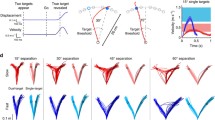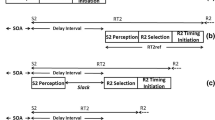Abstract
Fitts’ law predicts that there is an essential trade-off between speed and accuracy during movement. Past investigations of Fitts’ law have not characterized whether advance planning of upcoming fast and accurate movements impacts either behavior or patterns of brain activation. With an event-related functional magnetic resonance imaging (fMRI) paradigm, we investigated the neural correlates of advance planning and movement difficulty of rapid, goal-directed aimed movements using a discrete version of the classic Fitts’ task. Our behavioral data revealed strong differences in response time, initial movement velocity, and end-point accuracy based on manipulation of both time to plan movements and response difficulty. We discovered a modulation of the neural network associated with executing the Fitts’ task that was dependent on the availability of time to plan the upcoming movement and motor difficulty. Specifically, when time to plan for the upcoming movement was available, medial frontal gyrus (BA 10), pre-SMA (BA 6), putamen and cerebellar lobule VI were uniquely active to plan movements. Further, their activation correlated with behavioral measures of movement. In contrast, manipulating movement difficulty invoked a different pattern of brain activations in regions that are known to participate in motor control, including supplementary motor area (BA 6), sensory motor cortex (BA 4, 3, 2) and putamen. Our finding that medial frontal gyrus (BA 10) was important for discrete, fast and accurate movements expands the known role of this brain region, which in the past has been identified as a cognitive processing system supporting stimulus-oriented attending. We now extend this conceptualization to include motor functions such as those employed for processing for rapid, goal-directed aimed movements.






Similar content being viewed by others
Notes
Resonance Technology Inc., 18121 Parthenia St.- Suite A, Northridge, CA 91325.
National Instruments Corp., 11500 N Mopac Expwy, Austin, TX 78759-3504.
\( {\text{RMSE}} = \sum\nolimits_{i = 1}^{n} {\left\{ {\left( {x_{i} -- T_{i} } \right)^{ 2} /n} \right\}^{{ 1/ 2 }} x_{i} = {\text{participant}}\,{\text{position}}\,{\text{at}}\,{\text{time 1}}, T_{i} = {\text{target}}\,{\text{position}}\,{\text{at}}\,{\text{t}}} {\text{ime 1}}, n = {\text{number of samples}}.\)
References
Alexander GE, Crutcher MD (1990) Functional architecture of basal ganglia circuits. Trends Neurosci 13:266–271
Baker SN, Spinks R, Jackson A, Lemon RN (2001) Synchronization in monkey motor cortex during a precision grip task I. Task-dependent modulation in single-unit synchrony. J Neurophysiol 85(2):869–885
Bengtsson SL, Ehrsson HH, Forssberg H, Ullen F (2005) Effector-independent voluntary timing: behavioural and neuroimaging evidence. Eur J NeuroSci 22(12):3255–3265
Bennett KMB, Lemon RN (1996) Corticomotoneuronal contribution to the fractionation of muscle activity during precision grip in the monkey. J Neurophysiol 75(5):1826–1842
Boecker H, Dagher A, Ceballos-Baumann O, Passingham RE, Samuel M, Friston KJ et al (1998) Role of the human rostral supplementary motor area and the basal ganglia in motor sequence control: investigations with H 2 15 O PET. J Neurophysiol 79(2):1070–1080
Boecker H, Jankowski J, Ditter P, Scheef L (2008) A role of the basal ganglia and midbrain nuclei for initiation of motor sequences. Neuroimage 39(3):1356–1369
Burgess PW, Dumontheil I, Gilbert SJ (2007a) The gateway hypothesis of rostral prefrontal cortex (area 10) function. Trends Cogn Sci 11(7):290–298
Burgess PW, Gilbert SJ, Dumontheil I (2007b) Function and localization within rostral prefrontal cortex (area 10). Philos Trans R Soc Lond B Biol Sci 362(1481):887–899
Burock MA, Buckner RL, Woldorff MG, Rosen BR, Dale AM (1998) Randomized event-related experimental designs allow for extremely rapid presentation rates using functional MRI. NeuroReport 9(16):3735–3739
Christoff K, Ream JM, Geddes LP, Gabrieli JD (2003) Evaluating self-generated information: anterior prefrontal contributions to human cognition. Behav Neurosci 117(6):1161–1168
Colebatch JG, Deiber MP, Passingham RE, Friston KJ, Frackowiak RSJ (1991) Regional cerebral blood-flow during voluntary arm and hand movements in human-subjects. J Neurophysiol 65(6):1392–1401
Cox RW (1996) AFNI: software for analysis and visualization of functional magnetic resonance neuroimages. Comput Biomed Res 29:162–173
Debaere F, Wenderoth N, Sunaert S, Van Hecke P, Swinnen SP (2003) Internal vs external generation of movements: differential neural pathways involved in bimanual coordination performed in the presence or absence of augmented visual feedback. Neuroimage 19(3):764–776
Debaere F, Wenderoth N, Sunaert S, Van Hecke P, Swinnen SP (2004) Changes in brain activation during the acquisition of a new bimanual coordination task. Neuropsychologia 42(7):855–867
Deiber MP, Passingham RE, Colebatch JG, Friston KJ, Nixon PD, Frackowiak RS (1991) Cortical areas and the selection of movement: a study with positron emission tomography. Exp Brain Res 84(2):393–402
Dum RP, Strick PL (1991) The origin of corticospinal projections from the premotor areas in the frontal lobe. J Neurosci 11(3):667–689
Elsinger CL, Harrington DL, Rao SM (2006) From preparation to online control: reappraisal of neural circuitry mediating internally generated and externally guided actions. Neuroimage 31(3):1177–1187
Ferber S, Mraz R, Baker N, Graham SJ (2007) Shared and differential neural substrates of copying versus drawing: a functional magnetic resonance imaging study. NeuroReport 18(11):1089–1093
Fitts PM (1954) The information capacity of the human motor system in controlling the amplitude of movement. J Exp Psychol 47:381–391
Forman SD, Cohen JD, Fitzgerald M, Eddy WF, Mintun MA, Noll DC (1995) Improved assessment of significant activation in functional magnetic resonance imaging (fMRI): use of a cluster-size threshold. Magn Reson Med 33(5):636–647
Gawthrop P, Lakie M, Loram I (2008) Predictive feedback control and Fitts’ law. Biol Cybern 98(3):229–238
Georgopoulos AP, Schwartz AB, Kettner RE (1986) Neuronal population coding of movement direction. Science 233:1416–1419
Gilbert SJ, Simons JS, Frith CD, Burgess PW (2006) Performance-related activity in medial rostral prefrontal cortex (area 10) during low-demand tasks. J Exp Psychol Hum Percept Perform 32(1):45–58
Grafton ST, Mazziotta JC, Woods RP, Phelps ME (1992) Human functional anatomy of visually guided finger movements. Brain 115:565–587
Haaland KY, Harrington DL, Knight RT (2000) Neural representations of skilled movement. Brain 123(Pt 11):2306–2313
Harrington DL, Boyd LA, Mayer AR, Sheltraw D, Lee RR, Huang M et al (2004) Neural representation of interval encoding and decision making. Cogn Brain Res 21:193–205
Hikosaka O, Sakai K, Miyauchi S, Takino R, Sasaki Y, Putz B (1996) Activation of human presupplementary motor area in learning of sequential procedures: a functional MRI study. J Neurophysiol 76(1):617–621
Hoshi E, Tanji J (2004) Differential roles of neuronal activity in the supplementary and presupplementary motor areas: from information retrieval to motor planning and execution. J Neurophysiol 92(6):3482–3499
Imamizu H, Miyachi S, Tamada T, Sasaki Y, Takino R, Putz B et al (2000) Human cerebellar activity reflecting an acquired internal model of a new tool. Nature 403:192–195
Inase M, Tokuno H, Nambu A, Akazawa T, Takada M (1999) Corticostriatal and corticosubthalamic input zones from the presupplementary motor area in the macaque monkey: comparison with the input zones from the supplementary motor area. Brain Res 833(2):191–201
Isoda M, Hikosaka O (2007) Switching from automatic to controlled action by monkey medial frontal cortex. Nat Neurosci 10(2):240–248
Isomura Y, Takada M (2004) Neural mechanisms of versatile functions in primate anterior cingulate cortex. Rev Neurosci 15(4):279–291
Kalaska JF, Cohen DAD, Prudhomme M, Hyde ML (1990) Parietal area 5 neuronal activity encodes movement kinematics, not movement dynamics. Exp Brain Res 80:351–364
Kelly RM, Strick PL (2003) Cerebellar loops with motor cortex and prefrontal cortex of a nonhuman primate. J Neurosci 23(23):8432–8444
Kertzman C, Schwarz U, Zeffiro TA, Hallett M (1997) The role of posterior parietal cortex in visually guided reaching movements in humans. Exp Brain Res 114(1):170–183
Lang CE, Bastian AJ (2002) Cerebellar damage impairs automaticity of a recently practiced movement. J Neurophysiol 87(3):1336–1347
Lemon RN, Mantel GW, Muir RB (1986) Corticospinal facilitation of hand muscles during voluntary movement in the conscious monkey. J Physiol 381:497–527
Luppino G, Matelli M, Camarda R, Rizzolatti G (1993) Corticocortical connections of area F3 (SMA-proper) and area F6 (pre-SMA) in the macaque monkey. J Comp Neurol 338(1):114–140
MacKenzie IS (1989) A note on the information-theoretic basis of Fitts’ law. J Mot Behav 21(3):323–330
MacKenzie CL, Marteniuk RG, Dugas C, Liske D, Eickmeier B (1987) Three-dimensional movement trajectories in Fitts’ task: implications for control. Q J Exp Psychol 39A:629–647
Maier MA, Armand J, Kirkwood PA, Yang HW, Davis JN, Lemon RN (2002) Differences in the corticospinal projection from primary motor cortex and supplementary motor area to macaque upper limb motoneurons: an anatomical and electrophysiological study. Cereb Cortex 12(3):281–296
Matsuzaka Y, Aizawa H, Tanji J (1992) A motor area rostral to the supplementary motor area (presupplementary motor area) in the monkey: neuronal activity during a learned motor task. J Neurophysiol 68(3):653–662
Miall C, Imamizu H, Miyachi S (2000) Activation of the cerebellum in co-ordinated eye and hand tracking movements: an fMRI study. Exp Brain Res 135:22–33
Mushiake H, Inase M, Tanji J (1991) Neuronal activity in the primate premotor, supplementary, and precentral motor cortex during visually guided and internally determined sequential movements. J Neurophysiol 66(3):705–718
Pohl PS, Winstein CJ (1998) Age-related effects on temporal strategies to speed motor performance. J Aging Phys Act 6(1):45–61
Pohl PS, Winstein CJ, Fisher BE (1996) The locus of age-related movement slowing: sensory processing in continuous goal-directed aiming. J Gerontol Ser B Psychol Sci Soc Sci 51(2):94–102
Porter R, Lemon RN (1993) Corticospinal function and voluntary movement. In (pp 61–89). Clarendon Press, Oxford
Rowe JB, Sakai K, Lund TE, Ramsoy T, Christensen MS, Baare WF et al (2007) Is the prefrontal cortex necessary for establishing cognitive sets? J Neurosci 27(48):13303–13310
Sakai K, Hikosaka O, Miyauchi S, Sasaki Y, Fujimaki N, Putz B (1999) Presupplementary motor area activation during sequence learning reflects visuo-motor association. J Neurosci 19(10):RC1
Schmahmann JD, Doyon J, McDonald D, Holmes C, Lavoie K, Hurwitz AS et al (1999) Three-dimensional MRI atlas of the human cerebellum in proportional stereotaxic space. Neuroimage 10(3):233–260
Schmahmann JD, Doyon J, Toga AW, Petrides M, Evans AC (2000) MRI atlas of the human cerebellum. Academic Press, San Diego
Schmidt D, Krause BJ, Weiss PH, Fink GR, Shah NJ, Amorim MA et al (2007) Visuospatial working memory and changes of the point of view in 3D space. Neuroimage 36(3):955–968
Simons JS, Scholvinck ML, Gilbert SJ, Frith CD, Burgess PW (2006) Differential components of prospective memory? Evidence from fMRI. Neuropsychologia 44(8):1388–1397
Spencer RM, Verstynen T, Brett M, Ivry R (2007) Cerebellar activation during discrete and not continuous timed movements: an fMRI study. Neuroimage 36(2):378–387
Stephan KE, Marshall JC, Penny WD, Friston KJ, Fink GR (2007) Interhemispheric integration of visual processing during task-driven lateralization. J Neurosci 27(13):3512–3522
Swick D, Turken AU (2002) Dissociation between conflict detection and error monitoring in the human anterior cingulate cortex. Proc Natl Acad Sci USA 99(25):16354–16359
Talairach J, Tournoux P (1988) Co-planar stereotaxic atlas of the human brain. Thieme, New York
Taniwaki T, Okayama A, Yoshiura T, Nakamura Y, Goto Y, Kira J et al (2003) Reappraisal of the motor role of basal ganglia: a functional magnetic resonance image study. J Neurosci 23(8):3432–3438
Tanji J (1994) The supplementary motor area in the cerebral cortex. Neurosci Res 19:251–268
Vaillancourt DE, Mayka MA, Corcos DM (2006) Intermittent visuomotor processing in the human cerebellum, parietal cortex, and premotor cortex. J Neurophysiol 95(2):922–931
Wang C, Ulbert I, Schomer DL, Marinkovic K, Halgren E (2005) Responses of human anterior cingulate cortex microdomains to error detection, conflict monitoring, stimulus–response mapping, familiarity, and orienting. J Neurosci 25(3):604–613
Winstein CJ, Pohl PS (1995) Effects of unilateral brain damage on the control of goal-directed hand movements. Exp Brain Res 105:163–174
Winstein CJ, Grafton ST, Pohl PS (1997) Motor task difficulty and brain activity: investigation of goal-directed reciprocal aiming using positron emission tomography. J Neurophysiol 77:1581–1594
Acknowledgments
Funding for this work was partially provided by an award from the North Growth Foundation. In addition, this project was also supported by a pilot grant award from the Hoglund Family Foundation. The Hoglund Brain Imaging Center is supported by Health Research and Services Administration C76HF00201.
Author information
Authors and Affiliations
Corresponding author
Rights and permissions
About this article
Cite this article
Boyd, L.A., Vidoni, E.D., Siengsukon, C.F. et al. Manipulating time-to-plan alters patterns of brain activation during the Fitts’ task. Exp Brain Res 194, 527–539 (2009). https://doi.org/10.1007/s00221-009-1726-4
Received:
Accepted:
Published:
Issue Date:
DOI: https://doi.org/10.1007/s00221-009-1726-4




